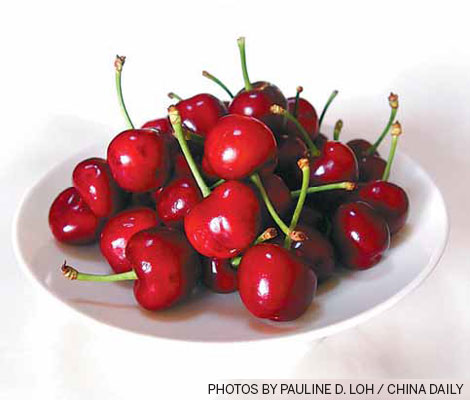
 |
| (Photo/China Daily) |
Cherries (Prunus cerasus)
We will not go into the complicated family history of the cherry. Suffice to say that what we are most familiar with now is the product of much cross-breeding, natural selection and careful nurturing.
It is interesting to note that, like many other fruits, the farmed fruit is thought to originate in China, but its cultivation had declined through the years.
Up until recently, you could hardly find an imported cherry in any market, but now there are lots of choices.
The dark maroon fruits from California are very popular and can command a hefty price, and are usually bought as gifts to impress friends or by homesick expatriates.
However, these Californian fruits are facing stiff competition from locally grown cherries - specifically those from Yantai in Shandong province, where the climate is conducive to the growth of both man and cherry. (The city was voted one of the best places in the world to live in, in a recent survey.)
Local cherries, smaller, paler but with stones that pop out easily also enjoy a brief season in early April. But, by late May and early June, the Shandong giants the size of large gumballs will be flooding the market.
These fruits are plump and juicy, with firm crisp flesh and a skin that pops open at first bite. They are pleasantly sweet but do not have the sugariness of lychee.
My younger colleagues told me that they are a dieter's delight.
Much as I like cherries, I find it hard to pop them like candy. It conjures up certain scenes from The Witches of Eastwick.
Instead, I like to cook with them, macerating them for jams and preserves, stoning them and using them in scones and cupcakes, and doing a cherry frangipane tart, for example.
Or, you may want to do a sour cherry sauce for pork chops or duck. I have yet to experiment with Chinese dishes, but I'll get there.
Buying Guide: Imported cherries are normally the red Bing, Washington State or the yellow Rainier cherries.
The imported fruits come packed in Styrofoam boxes so remember to soak them in lightly salted water when you get back home. A nice long soak, preferably overnight, will get rid of any residual pesticides or chemicals.
The same goes for any fruit that looks too perfect. There must be a reason why no insects got near them.
Local varieties from Shandong are the Large Black (dahei yingtao), Black Pearl (hei zhenzhu), Big Red Lantern (da hong denglong) and a yellow variety they call Amber Crystal (huang shuijing).
What to look for: Cherries must be firm to the touch. Do not buy any mushy fruit. They should also come with stalks mostly attached, and the stalks must be still fresh looking. If the stalks are dried up twigs, the cherries have been off the trees too long.
Here's a tip on how to stone cherries.
Get yourself a nice firm straw, like one of those that the 24-hour convenience shops give out with their frozen drinks.
Place the straw over the cherry stalk and push through. You'll find the cherry stone will be pushed out easily.
Stoned cherries can be used for eating or cooking, and they'll keep their shape.
Nutrition: The fruit is mainly dietary fiber and sugar, although it also has significant amounts of vitamin A and C, and various trace minerals. There is no cholesterol in the fruit and almost no fat. So, it is a good fruit for those on a diet.
(Source: China Daily)

















 A university graduate's shepherd career
A university graduate's shepherd career


![]()
